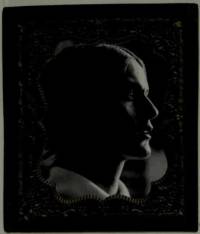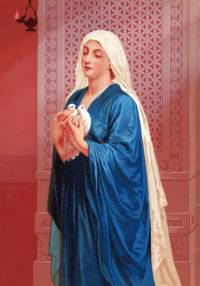border_districts
Border Districts
Book by Gerald Murnane.
Notes
Guard eyes while in town.
Allowing Curiosity to Infringe Upon Literature and the Imagination
The title of the painting the reproduction of which had so affected me was Mater Purissima. […] The painter was an Englishman of the late nineteenth or the early twentieth century whose name I forgot almost as soon as I had read it. Although the reproduction was in black and white, I was sometimes able to visualise a coloured version of the image of the young woman. It occurs to me today that the original of the painted image may well have been posed so that her face and shoulders were lit by way of some or another translucent window high above her and out of the scope of the painting. In my coloured version this light would surely have been a red-gold. The young woman was depicted as being clothed in an ankle-length robe with a transparent veil over her hair and holding a dove in each hand. Her hands were so positioned that each dove rested against one of her breasts. […] (I seem not to have noticed what I most notice now when I recall the image-birds: their improbable docility; they rest comfortably in the hands of the young woman with their own rounded breasts suggesting the shape of what lies hidden behind them under the folds of the young woman's robe and with their bright eyes focused, so it seems, on the same point of interest that the Most Pure Mother looks towards. Their pose is absurdly calm; they bear no resemblance to any of the struggling, frantic birds that I sometimes tried to hold as a boy.)
Page 31—

Gillian Tindall, from the dust jacket of The Born Exile: George Gissing.
Source: Internet Archive.
Source: Internet Archive.
The whole of the rear page of the dust-jacket of my copy of a certain biography of George Gissing is given over to a reproduction of a black and white photograph of the young female author of the book. She was photographed in profile. She chose, or she was directed, to stand side-on to the camera. It is not possible to tell from the vagueness surrounding her whether she posed indoors or outdoors; behind her is a wall of bricks or stones; in the background is another wall forming a right angle with the first; in the second wall is what seems at first glance a doorway leading to a brightly lit further room or out into bright daylight but may be no more than a rectangular patch of light reflected from some or another window or mirror beyond the range of the camera. Whenever I pick up the book and look anew at the rear dust-jacket, my eye is led at first to the seeming doorway but an instant later to an equally noticeable lighted area in the upper foreground. The author stares intently while a bright source from somewhere ahead of her forms zones of light on a part of her forehead, on her nearer cheekbone, on her chin, on the ridge of her nose, and on the cornea of her nearer eye. (Her further eye is hidden from view.) […] according to the dust-jacket of the first edition of her biography of him.
Page 55—
Female biographers of George Gissing:
- Gillian Tindall - The Born Exile: George Gissing, 1974.
- May Yates (Mary Ann Yates Corkling) - George Gissing: An Appreciation, 1922.
- Mabel Collins Donnelly - George Gissing: Grave Comedian, 1954.
- Emma Liggins - George Gissing, the Working Woman, and Urban Culture, 2006.
3ds
artist
audio
australia
cli
company
config
edf
film
fixes
form
game-maker
genre
guide
hardware
index
instrument
internet
japan
language
linux
list
multiplayer
music
music-making
nintendo
open-source
organisation
person
project
protocol
ps2
recommendations
sandlot
series
snes
software
song
sport
switch
theme
tool
translation
video
videogame
videogame-console
videogames
website
wiki
windows
border_districts.txt · Last modified: 2025/11/21 15:11 by rjt

